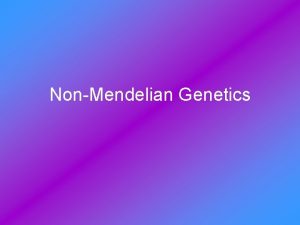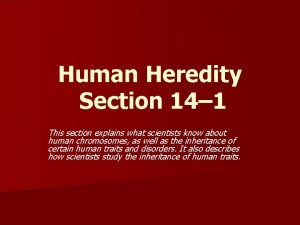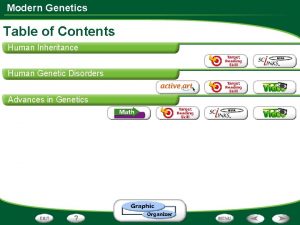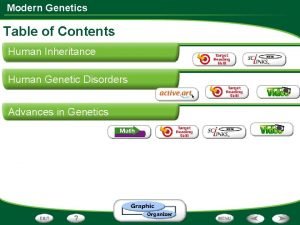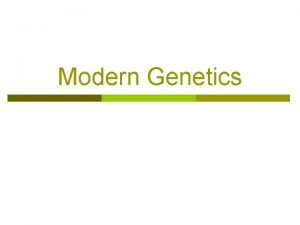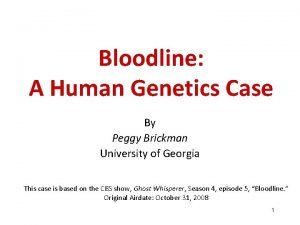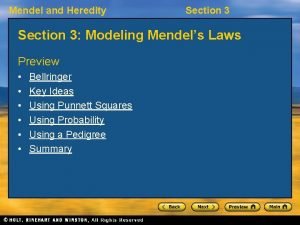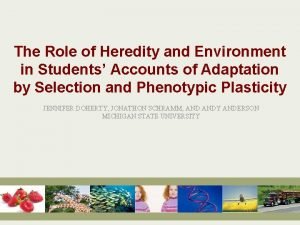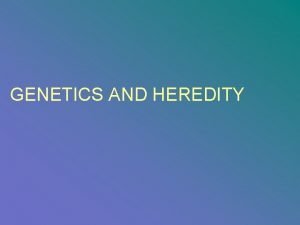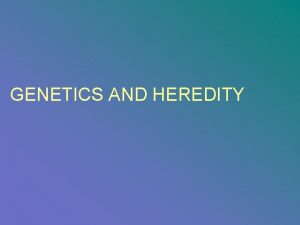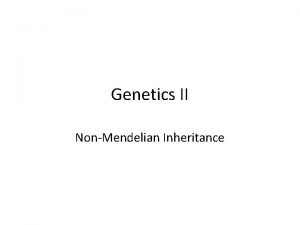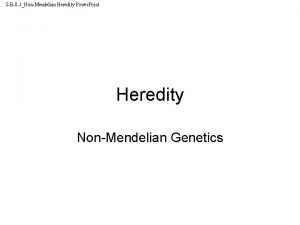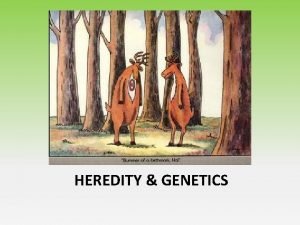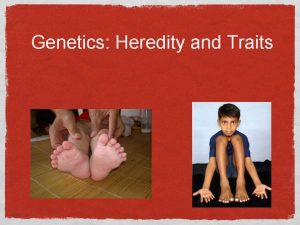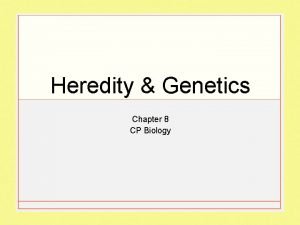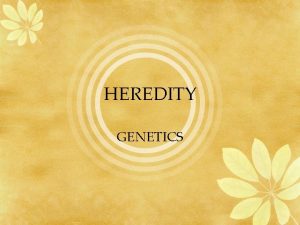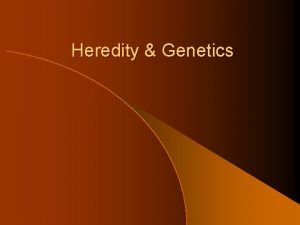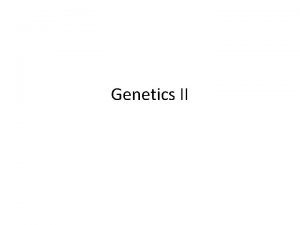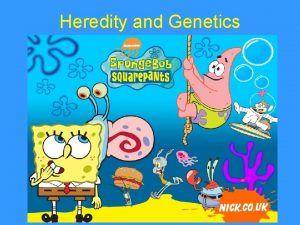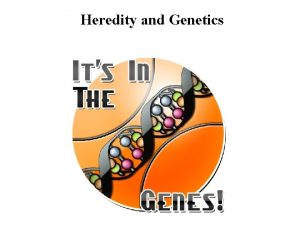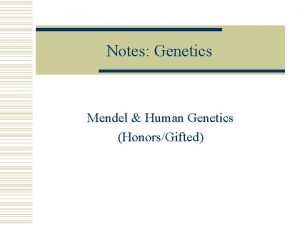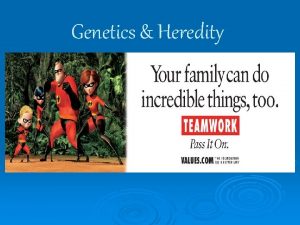NonMendelian and Human Heredity NonMendelian Genetics n Essential

















- Slides: 17

Non-Mendelian and Human Heredity

Non-Mendelian Genetics n Essential Questions: – 1. What happens when you have two alleles for a trait that are dominant? – 2. What is a blended phenotype? – 3. If two alleles are dominant, how do I identify which letter to use in the punnett square?

Incomplete Dominance n Neither allele is completely dominant n When the offspring is heterozygous, a third BLENDED phenotype appears

Incomplete Dominance Example n R R’ RR R R’ R’ R’ Phenotype ratio: Red 1, White 1, Pink 2 n If red flowers (RR) are incompletely dominant to white flowers (R’R’), show the offspring of a cross between 2 pink flowers (RR’) What is the probability that these two parents will produce pink offspring? – 50%

Codominance Both alleles are equally dominant n When the genotype is heterozygous, both phenotypes are represented in an almost equal ratio n Example: n – A black cow and a white cow may produce a black and white cow

Codominance Example W B BW BW BB BB Phenotype ratio: Black 2, black and white 2, white 0 n n If black chickens (BB) are codominant to white chickens (WW), show a cross between a black chicken (BB) and a black and white chicken (BW). What is the probability that these two chickens will have a white offspring? – 0%

Blood Typing – co-dominance and multiple allelism n n n More than two alleles are available for a trait Each individual will only have 2 of the alleles Example: Blood type (3 alleles- A, B, O) – “A” and “B” are co-dominant, “O” is recessive – Genotypes: n TYPE A - IA IA or IA i n TYPE B - IB IB or IB i n TYPE AB - IA IB n TYPE O – i i

Sex Linked inheritance Traits found on the X chromosome n More typical in males n Females: XX Males: XY n Examples of sex linked traits n – Color-blindness – Hemophilia - Male pattern baldness

Sex-Linked recessive n Color Blindness – One type of this disease (red-green) cannot distinguish between the colors red and green n Hemophilia – Lack a blood clotting enzyme and so cuts and wounds bleed without stopping

Sex-linkage Example Xb XB Y XB Xb Xb Y Xb n XB Xb Xb Y Phenotype: n • Both females are carriers (have normal vision but can pass on the trait) • Both males are color-blind A color blind woman (Xb Xb) and a man with normal vision (XBY) want to know what chance a son will have to have normal vision. What is the probability that these two people will have a color-blind son? – 100%

Techniques n Pedigree – Constructing and analyzing a graphical diagram of one trait over several past generations as well as the current generation n Population Sampling – Study a small randomly selected group to predict patterns in the entire population n Twin Studies – Study identical twins (they have the same DNA) to determine the role environment plays in the expression of our genes

Polygenic Inheritance More than one gene control a trait n Creates a wide range of phenotypes n – Ex. Height, skin color

Pedigree – diagram used to track one trait over several past generations as well as the current generation.

Karyotypes n The number, shapes, and sizes of the metaphase chromosomes constitute the karyotype n Some genetic abnormalities can be identified using karyotyping (ex. Down syndrome)

Genes vs. Environment n Environment can influence the expression of genes – Ex. Siamese cats fur gets darker in colder temperatures (phenotype changes) n Environmental hazards can create genetic mutations – Called mutagens – ex. UV radiation causes skin cancer n Twin studies are often used to study the influence of the environment on human traits

Essential Question n WHY are males more often affected with sex-linked genes? – Because the affected gene is on the X chromosome from the mother, and the father gives the boy a Y chromosome. Therefore the trait is expressed since the father can not give a boy a normal X chromosome. He can only give a boy a Y chromosome.

Essential Questions n Which type of inheritance produces a blended phenotype? – Incomplete Dominance n Which type of inheritance produces disorders most often seen in males? – Sex Linkage
 Nonmendelian traits
Nonmendelian traits Genes is the study of heredity and variation
Genes is the study of heredity and variation Chapter 17 the beginning of the life cycle
Chapter 17 the beginning of the life cycle Chapter 11 complex inheritance and human heredity test
Chapter 11 complex inheritance and human heredity test Section 14-1 human heredity
Section 14-1 human heredity Chapter 11 human heredity section 11-3
Chapter 11 human heredity section 11-3 Extra x
Extra x Introduction to genetic analysis tenth edition
Introduction to genetic analysis tenth edition Characteristics of lipids
Characteristics of lipids Human inheritance modern genetics answer key
Human inheritance modern genetics answer key Genetics graphic organizer
Genetics graphic organizer Modern genetics human inheritance answer key
Modern genetics human inheritance answer key 14-3 human molecular genetics answer key
14-3 human molecular genetics answer key Peggy brickman
Peggy brickman Section 3 mendel and heredity
Section 3 mendel and heredity Locus
Locus Role of heredity
Role of heredity Section 3 mendel and heredity
Section 3 mendel and heredity
